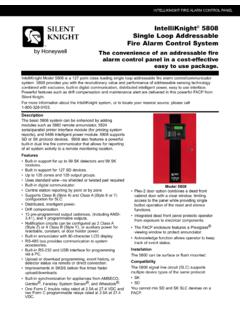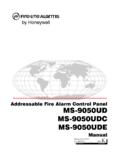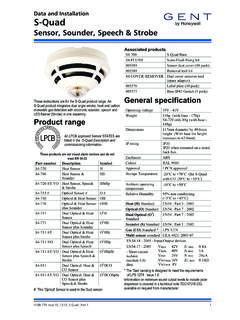Transcription of INTRINSICALLY SAFE ANALOGUE ADDRESSABLE …
1 INTRINSICALLY safe . ANALOGUE ADDRESSABLE . XP 95. smoke & heat detectors . BASEEFA approved E EX ia IIC T5 (T4 at Ta <. 60 C). ENGINEERING PRODUCT GUIDE. FIRE detectors LIMITED. XP95 INTRINSICALLY safe FIRE detectors . Apollo Fire detectors manufactures fire detectors designed The guide also provides information on intrinsic safety, the for use in hazardous areas. This Product Guide gives application and installation of the products and the information on the INTRINSICALLY safe ( ) version of the XP95 certification documentation. Reference is made to other ANALOGUE , ADDRESSABLE range of smoke and heat detectors product guides published by Apollo and the Guide to the which have been approved by BASEEFA. The approvals are to care, service and maintenance of Apollo products BS EN 60079-0:2004, BS EN 50284:1999, BS EN 50020:2002 (publication PP2055). All are available on request. and BS EN 60079-26:2004. All types are certified to EEx ia IIC.
2 T5 at ambient temperatures up to 40 C, or T4 at ambient Information in this guide is given in good faith, but Apollo temperatures up to 60 C. Fire detectors Limited cannot be held responsible for any omissions or errors. The company reserves the right to The range comprises ionisation and optical smoke detectors , change specifications of products at any time and without a temperature detector, a detector base and a compatible prior notice. manual call point. There is also a choice of two translators which ensure integrity of communication between detectors and control equipment within the constraints of an INTRINSICALLY safe system. FIRE detectors LIMITED. Page 2. TABLE OF CONTENTS. Introduction to Intrinsic Safety Page 4. Classification of Hazardous Areas Page 4. INTRINSICALLY safe Products Page 6. XP95 Ionisation smoke Detector Page 6. XP95 Optical smoke Detector Page 7. XP95 heat Detector Page 8. XP95 Base Page 8. XP95 Manual Call Points Page 9.
3 XP95 INTRINSICALLY safe Communications Protocol Page 10. XP95 Protocol Translator Page 10. Translator Operation Page 10. System Design Page 12. Types of Safety Barrier Page 13. Single Channel Page 13. Star-connected Barrier Page 13. Galvanically Isolated Barrier Page 13. Approved Safety Barriers Page 14. Safety Earth Page 15. Wiring and Cable Types Page 15. Maximum Loading of Circuit Page 16. Installation Page 16. Remote LED Connection Page 16. MiniDisc Remote Indicator Page 17. Servicing Page 18. Approvals Page 18. XP95 System Drawing Page 19. FIRE detectors LIMITED. Page 3. INTRODUCTION TO INTRINSIC SAFETY. There are many places where an explosive mixture of air transmitted outside the box. The surface must remain cool and gas or vapour is or may be present continuously, enough not to ignite the explosive mixture. intermittently or as a result of an accident. These are defined as hazardous areas by BS EN 60079, the code of practice for When flameproof equipment is interconnected, flameproof installation and maintenance of electrical apparatus in wiring must be used.
4 This method is most valuable when potentially explosive atmospheres. high power levels are unavoidable but it is not acceptable for areas in which an explosive gas/air mixture may be Hazardous areas are common in petroleum and chemical continuously present or present for long periods. engineering plants and in factories processing and storing gases, solvents, paints and other volatile substances. For this reason Apollo fire detectors are made INTRINSICALLY safe rather than flameproof. INTRINSICALLY safe equipment Electrical equipment for use in these areas needs to be operates at such low power and with such small amounts of designed so that it cannot ignite an explosive mixture, not stored energy that it is incapable of causing ignition: only in normal operation but also in fault conditions. There are a number of methods available to achieve this - oil in normal conditions immersion, pressurised apparatus and powder filling, for with a single fault (for ib classification).
5 Example, but the two in most common use are flameproof with any combination of two faults (for ia classification). enclosures and intrinsic safety. In any of these conditions every component must remain Flameproof equipment is contained in a box so strong that cool enough not to ignite the gases for which it is approved. an internal explosion will neither damage the box nor be CLASSIFICATION OF HAZARDOUS AREAS. BS EN 60079-10:2003 defines a hazardous area as one in which explosive gas/air mixtures are, or may be expected to be, present in quantities such as to require special precautions for the construction and use of electrical apparatus. The degree of risk in any area is a function of: the probability of an explosive mixture being present the type of gas which may be present the temperature at which a gas might ignite spontaneously These are defined in Table 1, Zone Classification, Table 2, Subdivision of Group II Gases and Table 3, Temperature Classification, respectively.
6 INTRINSICALLY safe Zone Definition Equipment Approval Required Zone 0 in which an explosive gas/air mixture is continuously present or present for long periods Ex ia Zone 1 in which an explosive gas/air mixture is likely to occur in normal operation Ex ia or Ex ib Zone 2 in which an explosive gas/air mixture is not likely to occur in normal operation and if it occurs it will exist only for a short time Ex ia or Ex ib XP95 detectors are approved to Ex ia and are suitable for all zones Table 1 Zone Classification FIRE detectors LIMITED. Page 4. INTRINSICALLY safe Representative Gas Other Gases, Liquids, Vapours Equipment Approval Required Hydrogen Carbon Disulphide Acetylene IIC. Ethylene Butadiene, Formaldehyde, Diethylether IIB or IIC. Methane Acetaldehyde, Acetone, Benzene, Butane, Ethane, Hexane, Heptane, Kerosene, Naphtha, Petroleum, Styrene, Xylene IIA or IIB or IIC. XP95 detectors are approved to IIC and may be used for all gases listed in PD IEC 60079-20:2000.
7 Table 2 Subdivision of Group II Gases Maximum Temperature Surface Gases, Liquids INTRINSICALLY safe Class Temperature Vapours Approval Required ( C). T6 85 T6. T5 100 Carbon Disulphide T5 or T6. T4 135 Acetaldehyde, Diethylether, Isopropylnitrate T4 or T5 or T6. T3 200 Hexane, Heptane T3 or T4 or T5 or T6. T2 300 Butane, Butadiene, T2 or T3 or T4 or T5. Ethylene or T6. T1 450 Acetone, Ammonia, Benzene, Carbon Monoxide, Ethane, Hydrogen, Methane, Propane, T1 or T2 or T3 or T4. Ethylene or T5 or T6. XP95 detectors are approved to T5 at 40 C and are suitable for all gases listed in PD IEC 60079-20:2000. Table 3 Temperature Classification FIRE detectors LIMITED. Page 5. Technical Data XP95 INTRINSICALLY safe Ionisation Specifications are typical and given at 23 C and 50%. relative humidity unless otherwise specified. Technical Data for the ionisation detector is identical to that for the standard version, except for the information given below: Detector Part No: 55000-540.
8 Base Part No: 45681-215. Supply Wiring: Two wire supply, polarity sensitive. Terminal Functions: L1: positive supply. L2: negative supply and remote LED negative. +R: remote LED positive. Notes: 1. detectors are polarity sensitive. Notes: 2. There is no requirement for series resistance INTRINSICALLY safe Ionisation smoke Detector on remote LED lines. Part no: 55000-540 Notes: 3. The remote LED characteristic differs from XP95, see page 16. XP95 INTRINSICALLY safe PRODUCTS Supply Voltage: 14-22 Volts dc. Quiescent Current: XP95 Ionisation smoke Detector 300 A. Operating Temperature: The sensing part of the detector consists of two chambers 20 C to +40 C (T5). an open, outer chamber and a reference chamber within. 20 C to +60 C (T4). Mounted in the reference chamber is a low-activity radioactive Remote LED Current: foil of Americium 241 which enables current to flow across the 1mA (internally limited). inner and outer chambers when the detector is powered up.
9 Guaranteed Temperature Range: As smoke enters the detector, it causes a reduction of the (No condensation or icing). current flow in the outer chamber and hence an increase in 20 C to +60 C. the voltage measured at the junction between the two chambers. This ANALOGUE voltage signal is converted to a BASEEFA Certificate No: digital signal by the electronic circuitry and transmitted to BAS02 ATEX1289. the control panel on interrogation. The micro-processor in Classification: the control equipment then compares the signal with stored E Ex ia IIC T5 (T4 at Ta 60 C). data and initiates a pre-alarm or fire alarm as smoke density increases. When a fire condition exists, the panel instructs the detector to switch on its indicator LED. There is no limit to the number of ionisation smoke detectors which may be installed in any fire protection system. Full details of the principles of operation and electrical description are published in the XP95 Engineering Product Storage regulations depend on local standards and Guide.
10 Information on the performance of XP95 in adverse legislation, but, in the UK, up to 500 detectors may be environmental conditions is also given in this guide. XP95 stored in any premises, although there are stipulations on detectors have the same operating characteristics as the storage facilities if more than 100 ionisation detectors are standard versions. stored in one building. At the end of their recommended working life of ten years, Safety Note ionisation smoke detectors should be returned to Apollo for safe disposal or disposed of in an otherwise locally In the United Kingdom, ionisation smoke detectors are approved and environmentally safe manner. Please see subject to the requirements of the Radioactive Substances "A guide to the care, maintenance and servicing of Apollo Act 1993 and to the Ionising Radiations Regulations 1999 made products", PP2055. under the provisions of the Health and Safety at Work Act 1974. Guidance on storage and handling can be given by Apollo The detectors , independently tested by the National Fire detectors and full details can be requested from: Radiological Protection Board (NRPB), conform to all the Radioactive Substances Regulation Function requirements specified in the Recommendations for Environment Agency ionisation smoke detectors in implementation of radiation Rio House, Waterside Drive standards' published by the Nuclear Energy Agency of the Aztec West, Almondsbury Organisation for Economic Co-operation and Development Bristol BS32 4UD.





